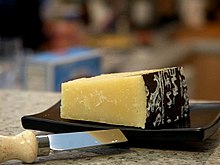You can help expand this article with text translated from the corresponding article in Italian. (July 2024) Click [show] for important translation instructions.
|
| Pecorino romano | |
|---|---|
 | |
| Country of origin | Italy |
| Region | |
| Source of milk | Sheep |
| Pasteurised | Yes |
| Texture | Hard and very crumbly |
| Aging time | 5 months or more |
| Certification | PDO: 1996 |
Pecorino romano (Italian: [pekoˈriːno roˈmaːno]; lit. 'Roman pecorino') is a hard, salty Italian cheese made from sheep's milk, often used for grating over pasta or other dishes. The name pecorino simply means 'ovine' or 'of sheep' in Italian; the name of the cheese, although protected, is a description rather than a brand: [formaggio] pecorino romano simply means 'sheep's [cheese] of Rome'.
Although this variety of cheese originated in Lazio, as the name also indicates, most of its actual production has moved to the island of Sardinia.[1] Pecorino romano is an Italian product with name recognised and protected by the laws of the European Union.
Pecorino romano was a staple in the diet for the legionaries of ancient Rome. Today, it is still made according to the original recipe and is one of Italy's oldest cheeses. On the first of May (May Day), Roman families traditionally eat pecorino with fresh fava beans during a daily excursion in the Roman Campagna. It is mostly used in central and southern Italy.
- ^ Damiana Verucci (18 October 2016). "Lazio contro Sardegna, scoppia la guerra del pecorino romano" [Lazio against Sardinia, the Roman pecorino war breaks out]. Il Tempo (in Italian).